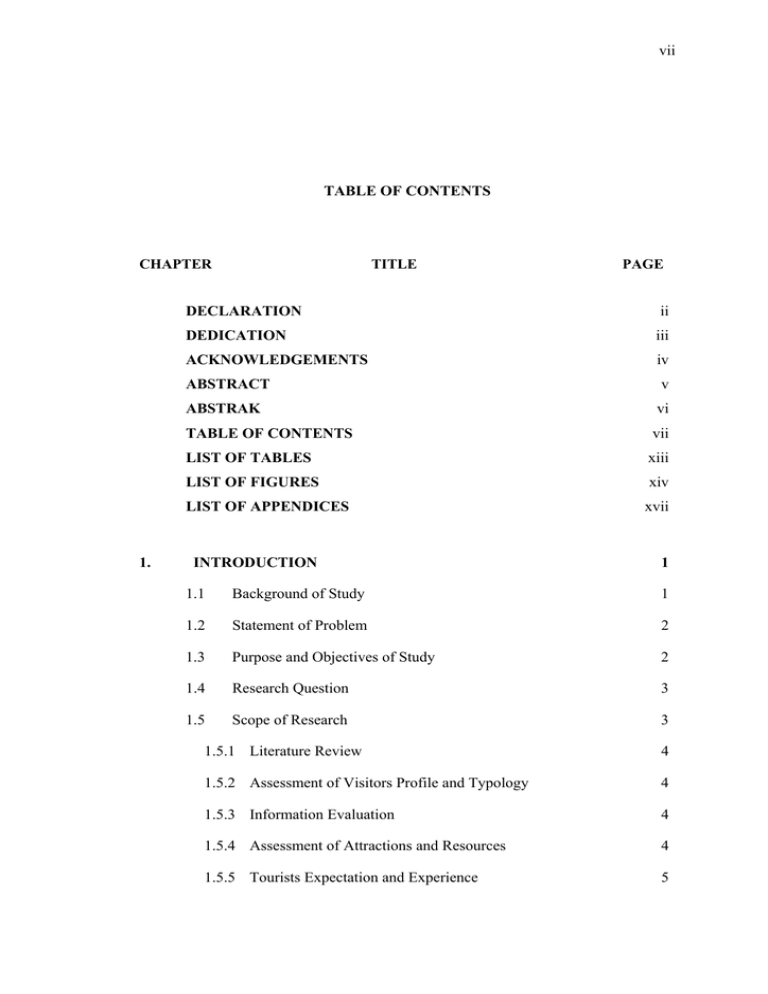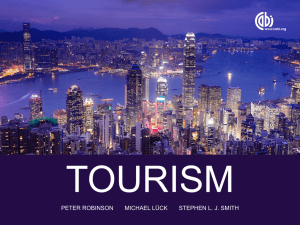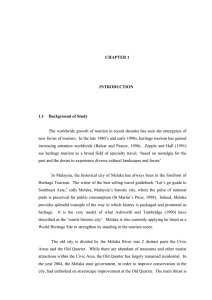vii ii iii
advertisement

vii TABLE OF CONTENTS CHAPTER 1. TITLE PAGE DECLARATION ii DEDICATION iii ACKNOWLEDGEMENTS iv ABSTRACT v ABSTRAK vi TABLE OF CONTENTS vii LIST OF TABLES xiii LIST OF FIGURES xiv LIST OF APPENDICES xvii 1INTRODUCTION 1 1.1 Background of Study 1 1.2 Statement of Problem 2 1.3 Purpose and Objectives of Study 2 1.4 Research Question 3 1.5 Scope of Research 3 1.5.1 Literature Review 4 1.5.2 Assessment of Visitors Profile and Typology 4 1.5.3 Information Evaluation 4 1.5.4 Assessment of Attractions and Resources 4 1.5.5 Tourists Expectation and Experience 5 viii 1.5.6 Tourists Behaviour 5 1.5.7 Tourists Overall Satisfaction 5 1.5.8 Assess Changes Happening At the Old Quarter 5 1.5.9 Understanding Cultural Heritage Management 6 1.5.10 Understanding Visitor Impact Management 6 1.6 6 1.6.1 Stage 1 – Preliminary Stage 6 1.6.2 Stage 2- Data Collection 6 1.6.3 Stage 3 - Analysis and Synthesis 8 1.6.4 Stage 4 – Recommendation 8 1.7 2. Study Approach Research Method and Research Instruments 8 1.7.1 Quantitative Research Method 8 1.7.2 Expectancy Disconfirmation Method 9 1.7.3 Research Instruments 9 1.7.3.1 Questionnaires 9 1.7.3.2 Interview 10 1.7.3.3 Non Participant Observation 11 1.8 Population and Sampling 11 1.9 Actual Survey 11 1.10 Study Area 13 1.11 Significance of the Study 13 1.12 Limitation of the Study 14 2CULTURAL HERITAGE MANAGEMENT AND TOURISM 15 2.1 Introduction 15 2.2 Heritage 15 2.2.1 Defining Heritage 15 2.2.2 Heritage Components 16 ix 2.2.3 World Heritage Listing 16 2.2.4 Cultural Heritage Management 17 2.3 3. Tourism 19 2.3.1 Urban Tourism 19 2.3.2 Heritage Tourism 20 2.3.3 Tourist Motivation 21 2.3.4 Typology of tourists 23 2.3.5 Common impacts related to visitor use 24 2.3.6 Visitor Impact Management 24 2.4 Tourism versus Conservation 25 2.5 Inventory of Attractions 25 2.6 The Streetscape 26 2.7 Conclusion 26 3STUDY AREA 28 3.1 Introduction 28 3.2 Tourism in Melaka 28 3.3 The Old Quarter of Melaka 30 3.4 Tourists Attractions and Resources Attractions 32 3.4.1 Manmade Attractions Designed for Tourists 32 3.4.1.1 Baba Heritage Museum 32 3.4.1.2 Cheng Ho Cultural Museum 33 3.4.1.3 Heeren Guest House 33 3.4.1.4 Baba House 33 3.4.1.5 Hotel Puri 34 3.4.1.6 The Orang Utan House 34 3.4.1.7 Artisan Enclave 34 3.4.1.8 Souvenir Shops 35 3.4.1.9 Antique Shops 35 x 3.4.1.10 Reptile Encounter 35 3.4.2 Manmade Buildings and Sites Not Originally Designed For Tourists 3.4.2.1 Kampung Kling Mosque 36 3.4.2.2 Kampung Hulu Mosque 36 3.4.2.3 Cheng Hoon Teng Temple 36 3.4.2.4 Sri Poyyatha Vinayagar Moorthy Temple 37 3.4.2.5 Munshi Abdullah’s house 37 3.4.2.6 No 8 Heeren Street 37 3.4.2.7 Hokkien Huay Kuan Clan House 38 3.4.2.8 Tomb of Hang Kasturi 38 3.4.2.9 Tomb of Hang Jebat 38 3.4.2.10 Wah Aik Bound Feet Shoe Maker 39 3.4.2.11 Clog Maker 39 3.4.2.12 Goldsmith 39 3.4.2.13 Blacksmith 40 3.4.2.14 Coffee Shops 40 3.4.2.15 Trishaw Ride 40 3.4.3 Special Events 3.4.3.1 4. 36 Jonker Walk 41 41 3.5 The Streetscape Improvement 41 3.6 Conclusion 43 4DATA ANALYSIS 44 4.1 44 Data Analysis Method 4.1.1 Percentage 44 4.1.2 Average Score 45 4.2 Pilot Test 45 4.3 Analysis 45 4.3.1 Profile of Visitor 4.3.1.1 Demographics 45 45 xi 4.3.1.2 Visitor’s Origin 47 4.3.1.3 Party Composition 49 4.3.1.4 Purpose of Visit to Melaka 49 4.3.1.5 Purpose of Visit to the Old Quarter 50 4.3.2 Planning the Visit 51 4.3.2.1 Number of Prior Trips to Melaka 51 4.3.2.2 Number of Prior Trips to the Old Quarter 51 4.3.3 Sources of Information Used In Planning the Trip 52 4.3.4 Adequateness of the Information Provided About the Old Quarter 53 4.3.5 Importance of Cultural Heritage in Deciding To Come To Melaka 54 4.3.6 Willingness to Participate to Gain Deep Cultural Experience in Melaka 4.3.7 Visitor Experience 4.4 54 55 4.3.7.1 Length of Visit to Melaka 55 4.3.7.2 Visitor Overall Satisfaction 55 4.3.7.3 Likelihood to Revisit 56 4.3.7.4 Likelihood to Making Recommendation 56 Evaluating the Attractions at the Old Quarter 57 4.4.1 Heard Before 58 4.4.2 Interested to visit 60 4.4.3 Actual Visitation 62 4.5 Experience at the Attractions 64 4.5.1 Information Availability at the Attractions 65 4.5.2 Activities at the Attractions 65 4.5.3 Satisfaction at the Attractions 66 4.6 Tourists Behaviour at the Old Quarter 66 4.6.1 Mode of transportation in the Old Quarter 66 4.6.2 Willingness to Venture to Inner Alleys 67 xii 4.6.3 Willingness to walk on both sides of the street 67 4.6.4 The Pedestrian Walkway Influences the Choices of Attractions Visited 4.7 Expectation Disconfirmation 69 4.8 Tourist Flow Pattern 70 4.8.1 Changes in Shop Compositions 5. 68 70 4.9 Recommendations from Tourists 73 4.10 Conclusion 74 5DISCUSSION, RECOMMENDATION, AND CONCLUSION 76 5.1 Introduction 76 5.2 Discussion of Findings 76 5.3 Recommendation from Findings 78 5.3.1 Creation of an Alternative Honeypot 78 5.3.2 Creation of a heritage trail 79 5.3.3 Information availability 79 5.4 5.3.3.1 Pre-trip information: Promotion 80 5.3.3.2 During-trip information: Map and Interpretative Panels 80 Conclusion 81 REFERENCES 84 APPENDICES 88 xiii LIST OF TABLES: TABLE NUMBER TITLE PAGE 2.1 Cultural Heritage Management Principles 17 2.2 Impact of Tourism on a Cultural Heritage Asset 24 3.1 Visitor Arrivals to Melaka 29 3.2 The Top 10 Countries of International Tourists Visiting Melaka 29 4.1 Summary of Evaluation of Attractions and Resources 57 4.2 Summary of Attractions Awareness 58 4.3 Summary of Attractions Attractiveness 60 4.4 Summary of Attractions Visited 62 4.5 Level of Information, Activities, and Satisfaction at the Attractions 64 4.6 Summary of Information Availability at the Attractions 65 4.7 Summary of Activities Level at the Attractions 65 4.8 Summary of Satisfaction Level at the Attractions 66 4.9 Expectation Disconfirmation at the Old Quarter 69 4.11 Current Shop Compositions along the Study Area 72 4.10 Recommendations from Tourists 73 xiv LIST OF FIGURES: FIGURE NUMBER TITLE 1.1 Study Approach 1.2 Map of the Old Quarter of Melaka Showing the Study area and PAGE 7 Sampling Stations 12 2.1 The Various Functions of Urban Tourism 19 2.2 The Motivation Process 22 2.3 Typology of Cultural Tourists 23 3.1 Melaka Circa 1744 (Dutch Era) 30 3.2 Map of the Old Quarter of Melaka Showing the Pedestrian Walkway 31 3.3 Baba Heritage Museaum 32 3.4 Cheng Ho Cultural Museum 33 3.5 Heeren Guest House 33 3.6 Baba House 33 3.7 Hotel Puri 34 3.8 The Orang Utan House 34 3.9 Artisan Enclave 34 3.10 Souvenir Shop 35 3.11 Antique Shop 35 3.12 Reptile Encounter 35 3.13 Kampung Kling Mosque 36 3.14 Kampung Hulu Mosque 36 3.15 Cheng Hoon Teng Temple 36 3.16 Sri Poyyatha Vinayagar Moorthy Temple 37 3.17 Munshi Abdullah’s House 37 3.18 No 8 Heeren Street 37 3.19 Hokkien Huay Kuan Clan House 38 xv 3.20 Tomb of Hang Kasturi 38 3.21 Tomb of Hang Jebat 38 3.22 Wah Aik Bound Feet Shoe Maker 39 3.23 Clog Maker 39 3.24 Goldsmith 39 3.25 Blacksmith 40 3.26 Coffee Shops 40 3.27 Trishaw Ride 40 3.28 Jonker Walk 41 3.29 Location of Attractions and pedestrian walkway in the Study Area 42 4.1 Gender of Respondents 46 4.2 Age of Respondents 46 4.3 Education Attainment 47 4.4 Occupation 47 4.5 Visitors Origin 48 4.6 Domestic Visitors Origin 48 4.7 International Visitors Origin 49 4.8 Party Composition 49 4.9 Purpose of Visit to Melaka 50 4.10 Purpose of Visit to the Old Quarter 51 4.11 Number of Prior Trip to Melaka 51 4.12 Number of Prior Trip to the Old Quarter 52 4.13 Source of Information to Plan This Trip 52 4.14 International Tourists Assessment on the Adequateness of Information about the Old Quarter 4.15 53 Domestic Tourists Assessment on the Adequateness of Information about the Old Quarter 53 4.16 Importance of Cultural Heritage in Decision to Visit Melaka 54 4.17 Willingness to Gain Deep Cultural Experience 54 4.18 Duration of Trip to Melaka 55 4.19 Tourists Satisfaction 55 4.20 Intention to Revisit 56 4.21 Likely to Recommend 56 4.22 Tourists Level of Awareness on Attractions at the Study Area 59 xvi 4.23 Tourists Level of Interest to Visit the Attractions at the Study Area 61 4.24 Actual Tourists Visitation Level at the Study Area 63 4.25 Mode of Transportation in the Old Quarter 67 4.26 Willingness to Venture to Inner Alleys 67 4.27: Willingness to Walk on Both Sides of the Street Even the Sides Without Pedestrian Pavement. 4.28 68 Influence of Pedestrian Walkway on the Choices of Attractions Visited. 68 4.29 Performance Vs Expectation Scatter 69 4.30 Tourists Flow Pattern in the Old Quarter of Melaka 71 5.1 Typology of Tourists at the Old Quarter of Melaka 76 xvii LIST OF APPENDICES APPENDIX TITLE PAGE A Questionnaire – Bahasa Melayu Version 88 B Questionnaire – English Version 92 C List of Premises Function Change at the Old Quarter 96

